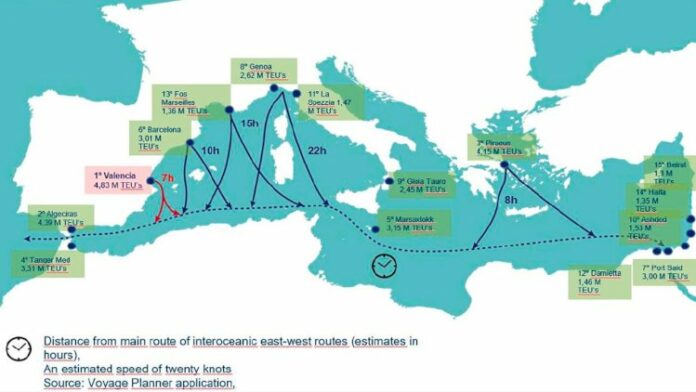The Port Authority of Valencia (PAV) has presented this morning its new tracking tool “Scale Times” in Valenciaport. This tool, unique in the world, is aimed primarily at shipowners and shipping companies and provides information on the time spent in the port, both in operating and idle time, as well as the degree of satisfaction in the different port services offered.
As explained by Aurelio Martínez:
“There is no international consensus in the way in which the port service should be measured, nor are the ports willing to provide that information. And this lack of information leads the sector to the inability to optimize its operations and, therefore, to an increase in costs. Therefore, the Scale Times tool that we are presenting today is unique in the world and is another example of Valenciaport’s commitment to transparency.
The level of efficiency of the ports – the president of the PAV has continued – must be measured by the times of call. It is a key indicator to articulate the rotation times of ships and, therefore, affects the programming of shipping companies. But, in addition, it directly influences both direct costs, fees, and indirect costs and is vital in the decarbonization processes of ports. Therefore, it is necessary to know both the operating times and idle times of the vessels in our enclosures. According to a study prepared by the Valenciaport Foundation, for a ship of 14,000 TEUs that scales in the port of Valencia, its inactivity within the enclosure implies a cost of $ 106.68 per minute”.
As explained by Aurelio Martínez:
“There is enormous potential to reduce idle times in ports. For our part, the savings can occur mainly in the terminals and, therefore, we want to advance the study by segmenting the time in the terminals to increase the efficiency of the analysis. It would be essential to have similar jobs in other ports in order to establish credible comparisons and find improvement points.”
The Portcall Times tool has been made based on the information on the scales collected by the Maritime Traffic Coordination and Control service for each of the 6,091 stopovers in Valenciaport between August 2018 and July 2019. For each of The scales have measured the time consumed in 12 variables: entry into port waters, anchorage, practical response to the entry, practical at the entrance of the ship, docking, beginning of operation, operating time, end of operation, practical response departure , practical in ship departure, scale and exit of port waters.
Likewise, the portcalls have been divided according to the typology of the ships that have docked in Valenciaport: general cargo, cruise ship, bulk carriers, Roro merancía, Roro Pax, tanks, container ships and others. In turn, in the case of container ships different types have been established depending on their size: small feeder (up to 999 TEU), regional feeder (between 1,000 and 1,999 TEU), feedermax (between 2,000 and 2,999 TEU), subpanamax ( between 3,000 and 3,999 TEU), panamax (between 4,000 and 5,446 TEU), postpanamax (between 5,447 and 9,999 TEU), VLCS (between 10,000 and 14,999 TEU) and ULCS (between 15,000 and 20,000 TEU).
The study concludes that the average time of a container ship without funding in Valenciaport is 28 hours and 29 minutes, of which 22 hours and 2 minutes is operating time. If the ship needs to anchor, the stop time in Valenciaport rises to 50 hours and 45 minutes, of which 21 hours and 53 minutes is operating time and more than 23 hours are dedicated to anchoring. With regard to larger container ships, the ULCS, the average stay in Valenciaport is 43 hours and 56 minutes, of which 38 hours and 41 minutes is operating time.
Of the total portcalls of container ships, 19% have needed funds. Of these, 77% corresponds to feeders and the largest number to regional feeder. In addition, the tool concludes that the average duration of the input maneuver for container ships is 50 minutes and the output 35 minutes. The relationship between operating time and berthing time is 84% on average (figure that rises to 94% in the case of the ULCS) and between operating time and scale time of 62% (86% in ULCS).
The Portcall times tool joins the numerous indicators launched by the Port Authority of Valencia to provide the port sector with proven information about its activity. In this regard, indicators aimed at importers and exporters have been launched, among which the VCFI and the connectivity index stand out. Specifically, the VCFI, on a monthly basis, allows exporters from the hinterland of Valenciaport to know the evolution of the freights they must pay for their shipments abroad. As for the connectivity index, published every six months, it is essential for exporters to know which are the direct destinations and the links of the port of Valencia with the main destinations in the world. Likewise, the PAV also regularly prepares the service quality and safety indicator.
Likewise, Valenciaport has indicators to show its competitive advantages, among which are: the “fun line”, the economic weight of each hinterland measured by a standard distance of 350 km, the evolution of the carbon footprint, the economic impact of the port in the Valencian Community and the social impact on the employment generated in the port environment.



